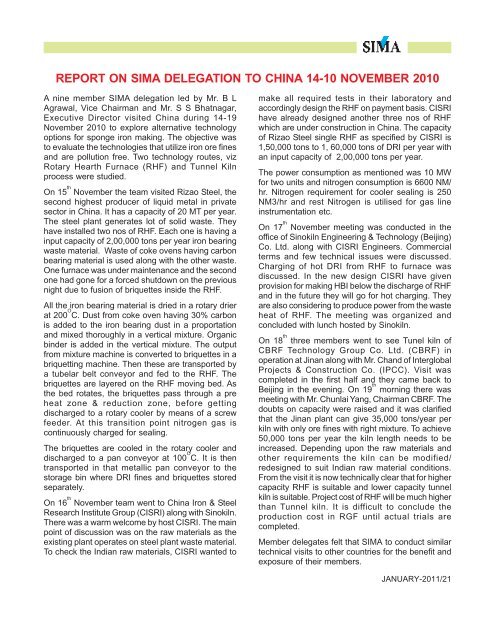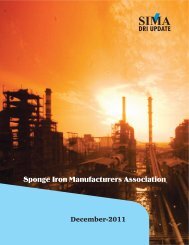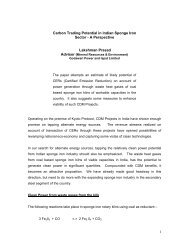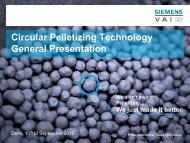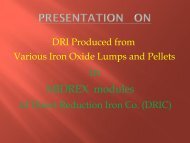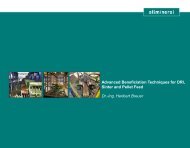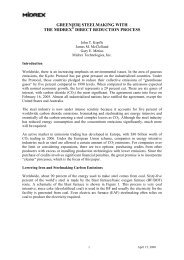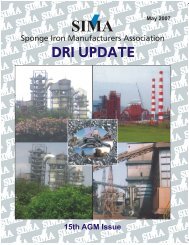sponge iron industry –past-present-future - SIMA
sponge iron industry –past-present-future - SIMA
sponge iron industry –past-present-future - SIMA
You also want an ePaper? Increase the reach of your titles
YUMPU automatically turns print PDFs into web optimized ePapers that Google loves.
REPORT ON <strong>SIMA</strong> DELEGATION TO CHINA 14-10 NOVEMBER 2010<br />
A nine member <strong>SIMA</strong> delegation led by Mr. B L<br />
Agrawal, Vice Chairman and Mr. S S Bhatnagar,<br />
Executive Director visited China during 14-19<br />
November 2010 to explore alternative technology<br />
options for <strong>sponge</strong> <strong>iron</strong> making. The objective was<br />
to evaluate the technologies that utilize <strong>iron</strong> ore fines<br />
and are pollution free. Two technology routes, viz<br />
Rotary Hearth Furnace (RHF) and Tunnel Kiln<br />
process were studied.<br />
On 15 th<br />
November the team visited Rizao Steel, the<br />
second highest producer of liquid metal in private<br />
sector in China. It has a capacity of 20 MT per year.<br />
The steel plant generates lot of solid waste. They<br />
have installed two nos of RHF. Each one is having a<br />
input capacity of 2,00,000 tons per year <strong>iron</strong> bearing<br />
waste material. Waste of coke ovens having carbon<br />
bearing material is used along with the other waste.<br />
One furnace was under maintenance and the second<br />
one had gone for a forced shutdown on the previous<br />
night due to fusion of briquettes inside the RHF.<br />
All the <strong>iron</strong> bearing material is dried in a rotary drier<br />
at 200 O<br />
C. Dust from coke oven having 30% carbon<br />
is added to the <strong>iron</strong> bearing dust in a proportation<br />
and mixed thoroughly in a vertical mixture. Organic<br />
binder is added in the vertical mixture. The output<br />
from mixture machine is converted to briquettes in a<br />
briquetting machine. Then these are transported by<br />
a tubelar belt conveyor and fed to the RHF. The<br />
briquettes are layered on the RHF moving bed. As<br />
the bed rotates, the briquettes pass through a pre<br />
heat zone & reduction zone, before getting<br />
discharged to a rotary cooler by means of a screw<br />
feeder. At this transition point nitrogen gas is<br />
continuously charged for sealing.<br />
The briquettes are cooled in the rotary cooler and<br />
discharged to a pan conveyor at 100 O<br />
C. It is then<br />
transported in that metallic pan conveyor to the<br />
storage bin where DRI fines and briquettes stored<br />
separately.<br />
On 16 th<br />
November team went to China Iron & Steel<br />
Research Institute Group (CISRI) along with Sinokiln.<br />
There was a warm welcome by host CISRI. The main<br />
point of discussion was on the raw materials as the<br />
existing plant operates on steel plant waste material.<br />
To check the Indian raw materials, CISRI wanted to<br />
make all required tests in their laboratory and<br />
accordingly design the RHF on payment basis. CISRI<br />
have already designed another three nos of RHF<br />
which are under construction in China. The capacity<br />
of Rizao Steel single RHF as specified by CISRI is<br />
1,50,000 tons to 1, 60,000 tons of DRI per year with<br />
an input capacity of 2,00,000 tons per year.<br />
The power consumption as mentioned was 10 MW<br />
for two units and nitrogen consumption is 6600 NM/<br />
hr. Nitrogen requirement for cooler sealing is 250<br />
NM3/hr and rest Nitrogen is utilised for gas line<br />
instrumentation etc.<br />
On 17 th<br />
November meeting was conducted in the<br />
office of Sinokiln Engineering & Technology (Beijing)<br />
Co. Ltd. along with CISRI Engineers. Commercial<br />
terms and few technical issues were discussed.<br />
Charging of hot DRI from RHF to furnace was<br />
discussed. In the new design CISRI have given<br />
provision for making HBI below the discharge of RHF<br />
and in the <strong>future</strong> they will go for hot charging. They<br />
are also considering to produce power from the waste<br />
heat of RHF. The meeting was organized and<br />
concluded with lunch hosted by Sinokiln.<br />
On 18 th<br />
three members went to see Tunel kiln of<br />
CBRF Technology Group Co. Ltd. (CBRF) in<br />
operation at Jinan along with Mr. Chand of Interglobal<br />
Projects & Construction Co. (IPCC). Visit was<br />
completed in the first half and they came back to<br />
Beijing in the evening. On 19 th<br />
morning there was<br />
meeting with Mr. Chunlai Yang, Chairman CBRF. The<br />
doubts on capacity were raised and it was clarified<br />
that the Jinan plant can give 35,000 tons/year per<br />
kiln with only ore fines with right mixture. To achieve<br />
50,000 tons per year the kiln length needs to be<br />
increased. Depending upon the raw materials and<br />
other requirements the kiln can be modified/<br />
redesigned to suit Indian raw material conditions.<br />
From the visit it is now technically clear that for higher<br />
capacity RHF is suitable and lower capacity tunnel<br />
kiln is suitable. Project cost of RHF will be much higher<br />
than Tunnel kiln. It is difficult to conclude the<br />
production cost in RGF until actual trials are<br />
completed.<br />
Member delegates felt that <strong>SIMA</strong> to conduct similar<br />
technical visits to other countries for the benefit and<br />
exposure of their members.<br />
JANUARY-2011/21


